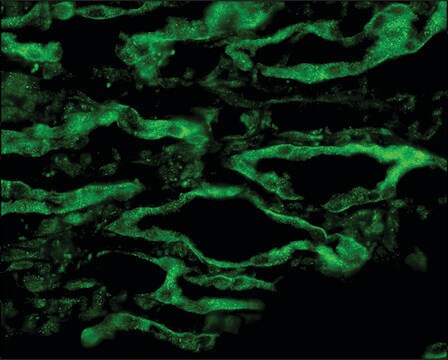AB3594
Anti-Aquaporin 4 Antibody, CT
Chemicon®, from rabbit
Sinónimos:
Mercurial-Insensitive Water Channel
About This Item
Productos recomendados
biological source
rabbit
Quality Level
antibody form
affinity isolated antibody
antibody product type
primary antibodies
clone
polyclonal
species reactivity
mouse, human, rat
manufacturer/tradename
Chemicon®
technique(s)
immunohistochemistry: suitable
western blot: suitable
NCBI accession no.
UniProt accession no.
shipped in
wet ice
target post-translational modification
unmodified
Gene Information
human ... AQP4(361)
General description
Specificity
Immunogen
Application
A previous lot of this antibody was used on rat brain sections.
Dilutions should be made using a carrier protein such as BSA (1-3%).
Western blotting:
1:500-1:1,000 using ECL on rat brain membranes.
Optimal working dilutions must be determined by the end user
Neuroscience
Ion & Transport Channels
Quality
Western Blot Analysis: 1:500 dilution of this lot detected AQUAPORIN 4 on 10 μg of Mouse Brain lysates.
Target description
Physical form
Storage and Stability
Analysis Note
Clear vial of RbX Aquaporin 4, CT Control Antigen(AB3594-50ULb) included free of charge with the antibody is 120 µg of control antigen (lyophilized powder). Reconstitute with 100 µL of PBS. For positive control, in Western blot use 20 ng of protein per Minigel lane. For negative control, preincubate 3 µg of purified peptide with 1 µg of antibody for one hour at room temperature. Optimal concentrations must be determined by the end user.
Other Notes
Legal Information
Disclaimer
¿No encuentra el producto adecuado?
Pruebe nuestro Herramienta de selección de productos.
wgk_germany
WGK 2
flash_point_f
Not applicable
flash_point_c
Not applicable
Certificados de análisis (COA)
Busque Certificados de análisis (COA) introduciendo el número de lote del producto. Los números de lote se encuentran en la etiqueta del producto después de las palabras «Lot» o «Batch»
¿Ya tiene este producto?
Encuentre la documentación para los productos que ha comprado recientemente en la Biblioteca de documentos.
Nuestro equipo de científicos tiene experiencia en todas las áreas de investigación: Ciencias de la vida, Ciencia de los materiales, Síntesis química, Cromatografía, Analítica y muchas otras.
Póngase en contacto con el Servicio técnico






